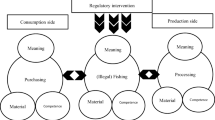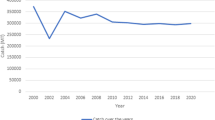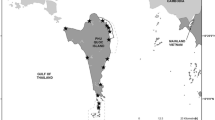Abstract
IUU (illegal, unreported, and unregulated) fishing causes severe detrimental social, economic, and environmental impacts worldwide. Although this practice is prohibited in Marine Protected Areas (MPA), practices such as fishing with compressor devices have been reported at the Marine Extractive Reserve of Corumbau (MERC), Brazil. In this case study we use data on MERC fisher knowledge and attitudes concerning compressor fishing gathered through semi-structured interviews to discuss MPA strengths and weaknesses in preventing IUU fishing. Interviewees strongly oppose IUU fishing, complaining it is one of the main reasons for declines in local fishing yield. Respondents indicate that non-local compressor vessels were frequently observed prior to the establishment of MERC, and while such sightings are now less frequent, these vessels continue to appear. At the same time, respondents also indicate that marine environmental enforcement actions are rare. We discuss the roles, potentials, and limitations of MPAs in preventing illegal fishing and protecting fishers from competition with industrial fishing. We recommend the IUU be vigorously combated in Brazilian MPAs.



Similar content being viewed by others
References
Agardy, T. (2017). Justified ambivalence about MPA effectiveness. ICES Journal of Marine Science. https://doi.org/10.1093/icesjms/fsx083
Agnew, D. J., Pearce, J., Pramod, G., Peatman, T., Watson, R., Beddington, J. R., Pitcher, T. J. (2009). Estimating the worldwide extent of illegal fishing. PLoS ONE. 4(2), e4570.
Albuquerque, U. P., Lucena, R. F. P., & Lins Neto, E. M. F. (2014) Selection of Research Participants. In U. P. Albuquerque, L. V. F. C. Cunha, R. F. P. Lucena & R. R. N. Alves (Eds.), Methods and Techniques in Ethnobiology and Ethnoecology (pp. 1-13). New York: Springer.
Allen, G. R. (1985). Snappers of the world: An annotated and illustrated catalogue of Lutjanid species known to date. Rome: FAO.
Andreu-Cazenave, M., Subida, M. D., Fernandez, M. (2018). Exploitation rates of two benthic resources across management regimes in central Chile: Evidence of illegal fishing in artisanal fisheries operating in open access areas. PLOS ONE 13(1), e0191166.
Bacalso, R. T. M., Juario, J. V., & Armada, N. B. (2013) Fishers’ choice of alternative management scenarios: A case study in the Danajon Bank, Central Philippines. Ocean & Coastal Management. 84, 40-53.
Barber, C.V. & Pratt, V. R. (1997) Policy reform and community-based programmes to combat cyanide fishing in the Philippines. In B. Johannes, & B. Hill (Eds.), Live Reef Fish Information Bulletin, (pp. 26-35). New Caledonia: Marine Resources Division.
Barbosa-Filho, M. L. V., Souza, G. B. G., Lopes, S. F., Siciliano, S., Hauser-Davis, R. A., Mourão, J. S. (2020). Evidence of shifting baseline and Fisher judgment on lane snapper (Lutjanus synagris) management in a Brazilian marine protected area. Ocean & Coastal Management. https://doi.org/10.1016/j.ocecoaman.2019.105025
Bardin, L. (2011). Análise de conteúdo. São Paulo: The Free Press.
Basurto, X. (2006). Commercial Diving and the Callo de Hacha Fishery in Seri Territory. Journal of the Southwest. 48(2), 189-209.
Bender, M., Floeter, S., Hanazaki, N. (2013a). Do traditional fishermen recognize reef fish species declines? Shifting environmental baselines in Eastern Brazil. Fisheries Management and Ecology.20, 58-67.
Bender, M. G., Floeter, S. R., Mayer, F. P., Vila-Nova, D. A., Longo, G. O., Hanazaki, N. et al. (2013b). Biological attributes and major threats as predictors of the vulnerability of species: a case study with Brazilian reef fishes. Oryx. 47, 259–265.
Brasil. (2000). Lei N°9.985, de 18 de julho de 2000. Regulamenta o art. 225, § 1°, incisos I, II, III, e VII da Constituição Federal, institui o Sistema Nacional de Unidades de Conservação da Natureza e dá outras providências. Diário Oficial da União, Brasília, 19 de julho de 2000, 138, Seção 1, 45.
Brasil. (2014). Listas das Espécies da Fauna Brasileira Ameaçadas de Extinção. Portaria MMA n° 445/2014. http://www.icmbio.gov.br/cepsul/images/stories/legislacao/Portaria/2014/p_mma_445_2014_lista_peixes_amea%C3%A7ados_extin%C3%A7%C3%A3o.pdf (accessed: 21 April 2019).
Caló, C. F., Schiavetti, A., & Cetra, M. (2009). Local ecological and taxonomic knowledge of snapper fish (Teleostei: Actinopterygii) held by fishermen in Ilhéus, Bahia, Brazil. Neotropical Ichthyology. 7(3), 403-414.
Castro e Silva, S. M. M., & Rocha, C. A. S. (1999). Embarcações, aparelhos e métodos de pesca utilizados nas pescarias de lagosta no estado do Ceará. Arquivos de Ciências do Mar. 32, 1-21.
Cetra, M., & Petrere-Jr, M. (2014). Seasonal and annual cycles in marine small-scale fisheries (Ilhéus – Brazil). Fisheries Management and Ecology. 21(3), 244-249.
Cha, S. G., Byun, Y. S., Jeon, M. J., Sakong, J. (2019). Diving patterns and decompression sickness among South Korean fishery divers. Journal of Occupational Health. 61, 143-153.
Chapman, D. D., Frisk, M. G., Abercrombie, D. L., Safina, C., Gruber, S. H., Babcock, E. A., Feldheim, K. A., Pikitch, E. K., Ward-Paige, C., Davis, B., Kessel, S., Heithaus, M. R., Worm, B. (2013). Give shark sanctuaries a chance. Science. 339, 757.
Coleman, F. C., Koenig, C. C., Huntsman, G. R., Musick, J. A., Eklund, A. M., McGovern, J. C. (2000). Long-lived reef fishes: The grouper-snapper complex. Fisheries. 25, 14-20.
Costa, P. A. S., Braga, A. C., & Rocha, L. O. F. (2003). Reef fisheries in Porto Seguro, eastern Brazilian coast. Fisheries Research. 60,567-583.
Davis, T. R., Harasti, D. (2020). Predictive modelling of illegal fishing in no-take marine protected areas. Fisheries, Management and Ecology. 00, 1–10.
Dutra, G. F., G. R. Allen, T. Werner and S. A. Mckenna. (2005) A Rapid Marine Biodiversity Assessment of the Abrolhos Bank, Bahia, Brazil, Washington, DC: RAP Bulletin of Biological Assessment.
Ennis, Z., & Aiken, K. (2014). Spearfishing as a potential threat to fishery sustainability in Jamaica: a survey of 23 fishing beaches. Revista de Biología Tropical. 62(3), 392-400.
Escobar, H. (2014) Com um arpão na mão e uma mangueira entre os dentes: Pescadores mergulham fundo em busca dos melhores peixes na região dos Abrolhos. Jornal impresso: Estadão.https://sustentabilidade.estadao.com.br/noticias/geral,com-um-arpao-na-mao-e-uma-mangueira-entre-os-dentes,1128171. Accessed 07 August 2018.
FAO. (2001). International Plan of Action to prevent, deter and eliminate illegal, unreported and unregulated fishing. Rome: FAO.
Fearnside, P. M. (2016). Brazilian politics threaten environmental policies. Science, 353, 746-748
Francini-Filho, R. B., & Moura, R. L. (2008). Dynamics of fish assemblages on coral reefs subjected to different management regimes in the Abrolhos Bank, eastern Brazil. Aquatic Conservation: Marine and Freshwater Ecosystems. 18, 1166–1179.
Gamarra, N. C., Correia, R. A., Bragagnolo, C., Campos-Silva, J. V., Jepson, P. R., Ladle, R. J., Malhado, A. C. M. (2019). Are Protected Areas undervalued? An asset-based analysis of Brazilian Protected Area Management Plans. Journal of Environmental Management. 249, 109347.
Giglio, V. J., Luiz, O. J., Gerhardinger, L. C. (2015) Depletion of marine megafauna and shifting baselines among artisanal fishers in eastern Brazil. Animal Conservation. 18, 348-358.
Giglio, V. J., Suhett, A. C., Zapelini, C. S., Ramiro, A. S., Quimbayo, J. P. (2019). Assessing captures of recreational spearfishing in Abrolhos reefs, Brazil, through social media. Regional Studies in Marine Science. 34, 100995.
Hilborn, R., & Ovando, D. (2014). Reflections on the success of traditional fisheries management. ICES Journal of Marine Science United Kingdom..71(5), 1040-1046.
Huntington, H. P. (2000). Using traditional ecological knowledge in science: methods and applications. Ecological Applications. 10, 1270–1274.
Ibama. (2003). Plano de Gestão da Reserva Extrativista marinha do Corumbau. Documento Base: Instituto Brasileiro de Meio Ambiente e dos Recursos Naturais Renováveis.http://www.icmbio.gov.br/portal/images/stories/biodiversidade/UC-RPPN/DCOM_ICMBio_plano_de_utilizacao_Resex_Corumbau_abril2016.pdf Accessed 04 April 2019.
Ibama. (2006). Instrução Normativa, 138/ 2006. Instituto Brasileiro do Meio Ambiente e dos Recursos Renováveis. Disponível em: <www.ibama.gov.br>. Acesso em 24 maio 2019
Ibama. (2008). Monitoramento da atividade pesqueira no litoral nordestino-Projeto Estatpesca. Boletim da Estatística da Pesca Marítima e Estuarina do Nordeste do Brasil – 2006. Tamandaré: CEPENE.
Icmbio. (2019). Reserva Extrativista Marinha de Corumbau. Ministério do Meio Ambiente. Site oficial. http://www.icmbio.gov.br/portal/populacoestradicionais/producao-e-uso-sustentavel/uso-sustentavel-em-ucs/4088-reserva-extrativista-marinha-de-corumbau Accessed 19 September 2019
Ismail, K., Kusasi, F., Fitriana, R. (2018). Fishers’ welfare in Natuna waters post IUU fishing policy implementation. Fellowship Report. Conservation Strategy Fund. https://www.conservation-strategy.org/sites/default/files/field-file/MFP_Natuna_English_Optimized.pdf Accessed 05 December 2019.
Kalikoski, D., Dias-Neto, J., Thé, A. P. G., Ruffino, M. L., & Marrul-Filho, S. (2008). Gestão compartilhada do uso sustentável de recursos pesqueiros: refletir para agir. Brasília: IBAMA.
Kelaher, B. P., Page, A., Dasey, M., Maguire, D., Read, A., Jordan, A., Coleman, M. A. (2015). Strengthened enforcement enhances marine sanctuary performance. Global Ecology and Conservation. 3, 503–510.
Khasanah, M., Nurdin, N., Sadovy de Mitcheson, Y., & Jompa, J. (2019). Management of the Grouper Export Trade in Indonesia, Reviews in Fisheries Science & Aquaculture. https://doi.org/10.1080/23308249.2018.1542420
Lester, S. E., Halpern, B.S., Grorud-Colvert, K., Lubchenco, J., Ruttenberg, B.I., et al. (2009). Biological effects within no-take marine reserves: A global synthesis. Marine Ecology Progress Series. 384, 33–46.
Malcolm, H. A., Williams, J., Schultz, A. L., Neilson, J., Johnstone, N., Knott, N. A., Jordan, A. (2018). Targeted fishes are larger and more abundant in ‘no-take’ areas in a subtropical marine park. Estuarine, Coastal and Shelf Science. 212, 118–127.
Marques, J. G. W. (2001). Pescando pescadores: Ciência e etnociência em uma perspectiva ecológica. São Paulo: NUPAUB.
Mesquita, E. M. C., & Isaac-Nahum, V. J. (2015). Traditional knowledge and artisanal fshing technology on the Xingu River in Pará, Brazil. Brazilian Journal of Biology. 75(3), 138-157.
Miller, A. M. M., Bush, S. R., & Mol, A.P. J. (2014). Power Europe: EU and the illegal, unreported and unregulated tuna fisheries regulation in the West and Central Pacific Ocean. Marine Policy. 45, 138–145.
Moretz-Sohn, C. D., Carvalho, T. P., Silva-Filho, F. J. N, Gastão, F. G. C., Garcez, D. S. Soares, M. O. (2013). Pescadores artesanais e a implementação de áreas marinhas protegidas: Estudo de caso no nordeste do Brasil. Revista de Gestão Costeira Integrada. 13(2), 193-204.
Moura, R. L., Dutra, G. F., Francini-Filho, R. B., Minte-Vera, C. V., Curado, I. B., Guimarães, F. J. et al. (2007). Fisheries Management in the Marine Extractive Reserve of Corumbau-Bahia. Brasília: Ministério do Meio Ambiente.
Moura, R. L., Minte-Vera, C. V. Curado, I. B., Francini-Filho, R. B., Rodrigues, C. L., Dutra, G. F. et al. (2009). Challenges and prospects of fisheries co-management under a Marine Extractive Reserve framework in Northeastern Brazil. Coastal Management. 37, 617-632.
Olavo, G., Costa, P. A., & Martins, A. S. (2005) Caracterização da pesca de linha e dinâmica das frotas linheiras da Bahia, Brasil. In P. A. Costa, A. S. Martins & G. Olavo (Eds.), Pesca e potenciais de exploração de recursos vivos na região central da Zona Econômica Exclusiva brasileira (pp. 13-34). Rio de Janeiro: Museu Nacional.
T. Pavlowich, & A. R. Kapuscinski (2017). Understanding spearfishing in a coral reef fishery: Fishers’ opportunities, constraints, and decision making. PLoS ONE 12(7). e0181617.
Pendleton, L. H., Ahmadia, G. N., Browman, H. I., Thurstan, R., Kaplan, D. M., Bartolino, V. (2017). Debating the effectiveness of marine protected areas. ICES Journal of Marine Science. https://doi.org/10.1093/icesjms/fsx154.
Prada, M., Castro, E., Grandas, Y., & Connolly, E. (2006). Effects of divers fishing in the San Andres Archipelago, considerations towards fisheries management and conservation. Florida: Secretaria de Agricultura y Pesca.
Pramod, G., Nakamura, K., Pitcher, T. J., & Delagran, L. (2014). Estimates of illegal and unreported fish in seafood imports to the USA. Marine Policy. 48, 102–13.
Previero, M., & Gasalla, M. A. (2018). Mapping fishing grounds, resource and fleet patterns to enhance management units in data-poor fisheries: The case of snappers and groupers in the Abrolhos Bank coral-reefs (South Atlantic). Ocean and Coastal Management. 154, 83–95.
Previero, M., Minte-Vera, C. V., & Moura, R. L. (2013). Fisheries monitoring in Babel: fish ethnotaxonomy in a hotspot of common names. Neotropical Ichthyology. 11(2), 467–476.
Radjawali, I. (2012). Examining local conservation and development: Live reef food fshing in Spermonde Archipelago, Indonesia. Journal of Integrated Coastal Zone Management. 12(4), 545-557.
Ricklefs, R. E. (2003). A economia da natureza, Rio de Janeiro: Guanabara Koogan.
Sadovy, Y. (1994). Grouper stocks of the western central Atlantic: the need for management and management needs. Proceedings of the Gulf and Caribbean Fisheries Institute. 43, 43-64.
Sala, E., Giakoumi, S. (2018). No-take marine reserves are the most effective protected areas in the ocean. ICES Journal of Marine Science. 75(3), 1166–1168.
Santos, A. N. (2015). Fisheries as a way of life: gendered livelihoods, identities and perspectives of artisanal fisheries in eastern Brazil. Marine Policy. 62, 279–288.
Simon, T., Pinheiro, H. T., Moura, R. L., Carvalho-Filho, A., Rocha, L. A., Martins, A.S. et al. (2016). Mesophotic fishes of the Abrolhos Shelf, the largest reef ecosystem in the South Atlantic. Journal of Fish Biology. https://doi.org/10.1111/jfb.12967
Sumaila, U. R., Guenette, S., Alder, J., Chuenpagdee, R. (2000). Addressing ecosystem effects of fishing using marine protected areas. ICES Journal of Marine Science. 57, 752 - 760.
Vasconcellos, M., Diegues, A. C., Kalikoski, D. C. (2011). Coastal fisheries of Brazil. In S. Salas, R. Chuenpagdee, A. Charles & J.C. Seijo (Eds), Coastal fisheries of Latin America and the Caribbean (pp. 73–116). Rome: FAO.
Woodcock, P., O'Leary, B. C., Kaiser, M. J., & Pullin, A. S. (2017). Your evidence or mine? Systematic evaluation of reviews of marine protected area effectiveness. Fish and Fisheries. 18(4), 668–681.
Zambonim, R., L. Wedekin and U. A. Farias. (2009). Nova Cartografa Social dos Povos e Comunidades Tradicionais do Brasil: comunidade de pescadores de Caravelas, Sul da Bahia. Manaus: Editora Universidade Federal do Amazonas.
Zapelini, C., Bender, M. G., Giglio, V. J., Schiavetti, A. (2019). Tracking interactions: Shifting baseline and fisheries networks in the largest Southwestern Atlantic reef system. Aquatic Conservation: Marine and Freshwater Ecosystems. https://doi.org/10.1002/aqc.3224
Acknowledgments
We thank all fishers at the Corumbau Marine Extractive Reserve, both for sharing their information and for indicating possible participants. Sergio C. Moreira kindly prepared the map. Special thanks are due to Ana Lúcia Sena Braz (Jandaya Pataxó), for all the logistical supports in the data collection phase.
Author information
Authors and Affiliations
Corresponding author
Ethics declarations
Conflict of Interest
The authors declare that they have no conflict of interest.
Funding
This study was financed in part by the Coordenação de Aperfeiçoamento de Pessoal de Nível Superior - Brasil (CAPES) - Finance Code 001. S. Siciliano is supported by CNPq (Produtividade em Pesquisa: 306076/2019–5) and INOVA Fiocruz.
Informed Consent
The present study was approved by the University of Pernambuco Research Ethics Committee involving human beings (Plataforma Brasil), under code CAAE 65458016.0.0000.5207. The fishers were briefed about the study protocol and informed consent was obtained from them.
Additional information
Publisher’s Note
Springer Nature remains neutral with regard to jurisdictional claims in published maps and institutional affiliations.
Appendix
Appendix
Appendix A – Survey used for the field interviews, highlighting the questions that generated information on compressor fishing, in bold.
Survey.
Pernambuco Rural Federal University.
Graduate Program in Ethnobiology and Nature Conservation.
Responsible Researcher: Márcio Luiz Vargas Barbosa Filho.
1 – General Fisher Information and Socioeconomic Profile
Date City Location.
Name Age Fishing Time.
Community/Association Schooling.
Income from fishing General income.
2 - Fishing Characterization
Name of the Vessel Do you own the vessel? Type Length.
Fishing Art Number of Arts Fishing Area.
Fishing frequency? Days at sea? Fishers per fishing trip?
Fished fish.
Q1 - Has fishing income decreased over the years? Why?
3 - Attitudes Concerning the MERC and its Fisheries Management Policy
What is the MERC?
Q2 - Why did you decide to create a MPA in the area?
Before the MERC, did you notice fishers from outside working here in the area? What did you think of that?
Q3 - Before the MERC implementation, what equipment did external boats fish with?
Q4– What do you think about the MERC today? Why?
If you could change anything at the MERC, would you? What? Why?
Do you think that something has changed in your life due to MERC?
For better or for worse? How? Why?
Q5 - Do you think the MERC has changed anything concerning fish protection?
What? Why?
Do you think something should be done to improve fishing at the MERC?
Q6 - Does anything currently happen in the local fishing scenario that should not happen? What?
Is there anything that does not happen today in fishing that should happen?
Do you think that the current fishing is very harmful to fish?
What? Why?
Q7 - Are you satisfied with the inspection that takes place today at the MERC? Why?
Rights and permissions
About this article
Cite this article
Barbosa-Filho, M.L.V., de Souza, G.B.G., de Faria Lopes, S. et al. Artisanal Fisher Knowledge and Attitudes Concerning Compressor Fishing in a North-Eastern Brazilian Marine Protected Area. Hum Ecol 48, 357–366 (2020). https://doi.org/10.1007/s10745-020-00156-2
Published:
Issue Date:
DOI: https://doi.org/10.1007/s10745-020-00156-2




